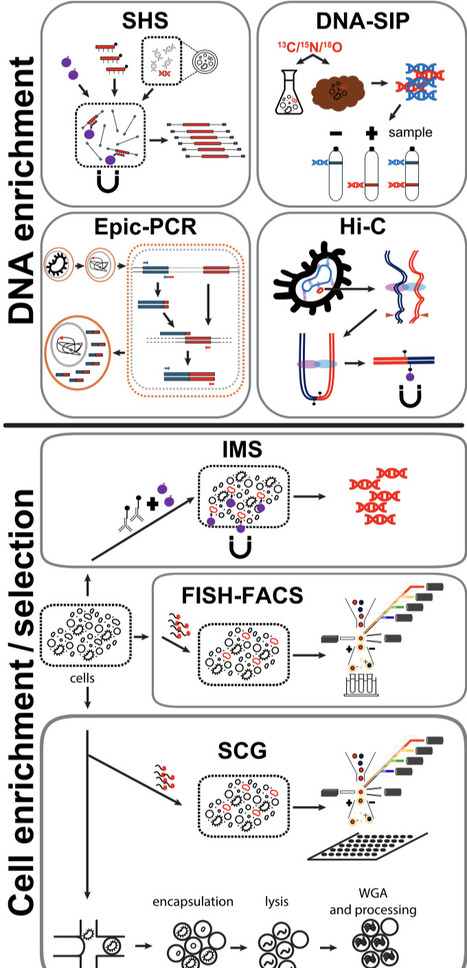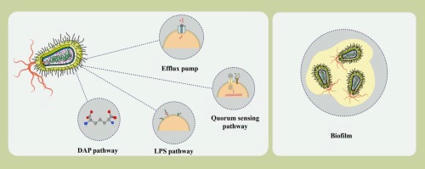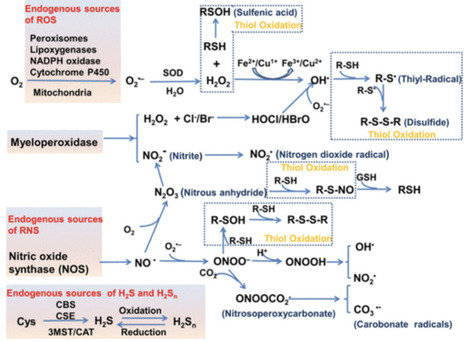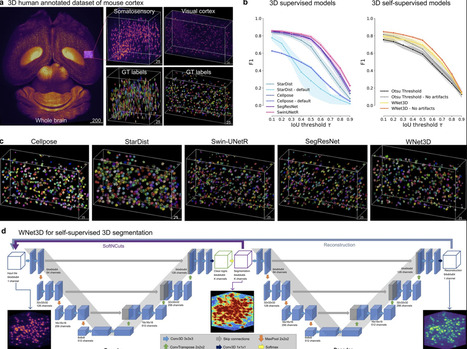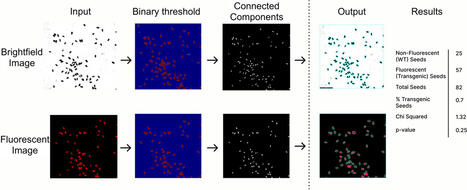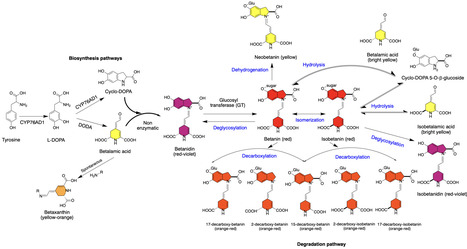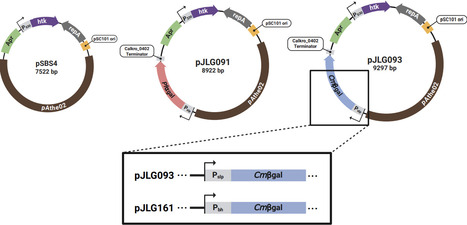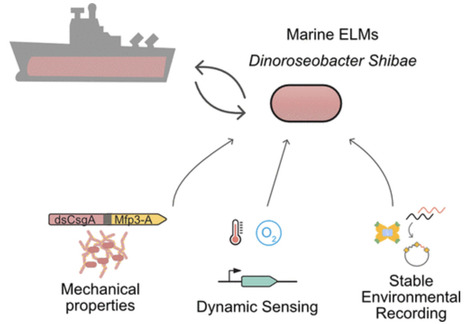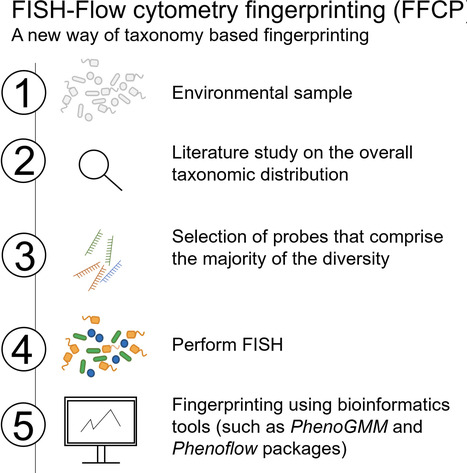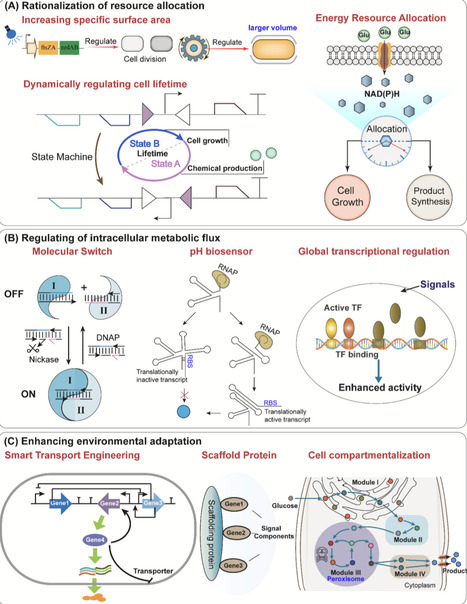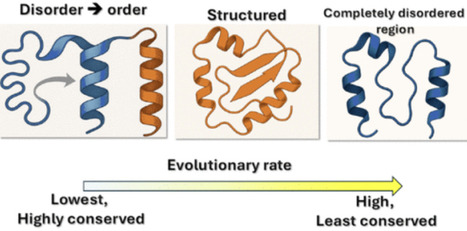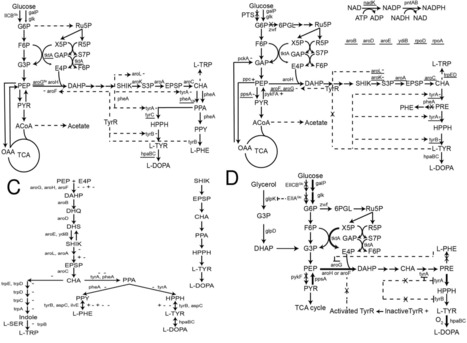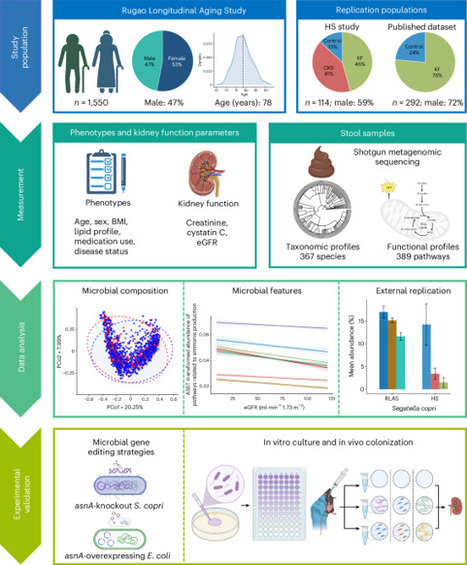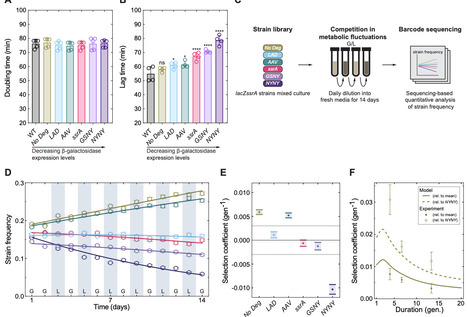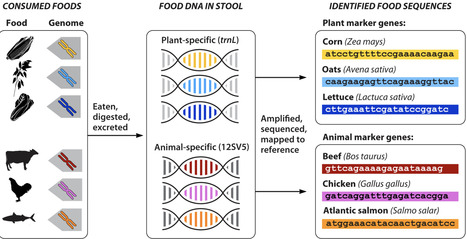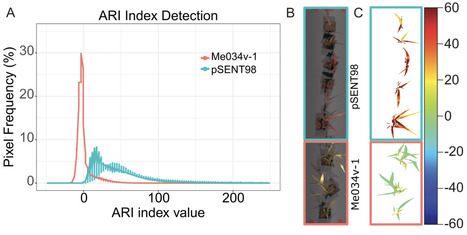 Your new post is loading...

|
Scooped by
?
Today, 11:02 AM
|
The rapidly developing field of targeted analysis of metagenomes focuses on retrieving information about specific genes and/or genome(s) from environmental DNA. The traditional shotgun sequencing methods over-emphasize dominant microorganisms and often fail to confidently assign the entirety of the analyzed genetic material to specific species, genomovars, or strains. The ultimate goal of the targeted methods is to overcome this limitation of throughput and precision of current shotgun metagenomics when analysing complex microbial communities in the quest of refined information. Here, we discuss recent technological advances that are designed to focus the analytical power of diagnostic tools like sequencing, towards phylogenetically or functionally distinct and rare microbial groups and enhance e.g. the confidence in the assignment of genetic elements to their respective owning organisms. We specifically showcase the capabilities of these technological advances for targeted analysis of metagenomes, identify suitable related applications, discuss methodological limitations, and propose solutions for addressing these limitations. This review aspires to inspire highly relevant experimental designs in the future that will unlock unknown and important aspects of microbial ecology, and the yet-uncultivated microbial majority.

|
Scooped by
?
Today, 10:52 AM
|
Pseudomonas aeruginosa, an opportunistic pathogen known for its adaptability, has become a critical health concern due to its inherent resistance to multiple antibiotic classes and its rapid acquisition of new resistance mechanisms. The rise of multidrug-resistant (MDR) and extensively drug-resistant (XDR) strains has further compounded the global burden of P. aeruginosa infections. Traditional antibiotic discovery efforts, which focus on essential bacterial processes such as cell wall synthesis, protein production, and DNA replication, have been unable to keep pace with the pathogen's evolving resistance strategies. Recent advancements in omics technologies have provided deeper insights into the complex biology of P. aeruginosa, including bacterial communication networks like quorum sensing and interactions between the host and pathogen that are crucial for the pathogen's survival and virulence. These insights pave the way for identifying novel therapeutic targets, such as unexplored metabolic pathways and virulence mechanisms, which could offer more effective strategies for combating resistant P. aeruginosa strains. In this review, we critically assess the limitations of conventional approaches and emphasize the potential of targeting these alternative pathways to address the growing challenge of antibiotic resistance. By exploring innovative strategies that transcend traditional methods, this review underscores the importance of pursuing novel therapeutic avenues that could lead to the development of more effective antibiotics against P. aeruginosa and similar resistant pathogens.

|
Scooped by
?
Today, 10:33 AM
|
Cellular redox homeostasis governs numerous essential biological processes and presents broad implications in human health and diseases. Cells maintain the redox homeostasis by expression of some types of oxidants, reductants, and redox-active metals, while processing elaborate mechanisms to regulate their internal redox status. These biomolecules can serve as biomarkers to identify the alterations in redox status. The cellular redox dysregulation indicates a crucial pathogenic mechanism in conditions such as inflammatory diseases, cancer, and neurodegenerative disorders. Consequently, exploring the self-regulatory mechanisms of cellular redox homeostasis and in situ imaging of redox changes have emerged as key research focuses. In this review, we focus on the biomolecules involved in redox maintenance and highlight their detailed regulatory mechanisms. Moreover, we systematically review recent progress in fluorescent probes responsive to biomarkers of redox changes, primarily over the past five years, including their design principles, reaction mechanisms, and bioimaging applications in redox-related diseases. This review concludes with a discussion of the challenges and prospects for redox regulation and imaging in the therapeutics and diagnostics of human diseases. We hope it can serve as a valuable resource for those interested in this rapidly expanding research field.

|
Scooped by
?
Today, 10:22 AM
|
Understanding the complex three-dimensional structure of cells is crucial across many disciplines in biology and especially in neuroscience. Here, we introduce a set of models including a 3D transformer (SwinUNetR) and a novel 3D self-supervised learning method (WNet3D) designed to address the inherent complexity of generating 3D ground truth data and quantifying nuclei in 3D volumes. We developed a Python package called CellSeg3D that provides access to these models in Jupyter Notebooks and in a napari GUI plugin. Recognizing the scarcity of high-quality 3D ground truth data, we created a fully human-annotated mesoSPIM dataset to advance evaluation and benchmarking in the field. To assess model performance, we benchmarked our approach across four diverse datasets: the newly developed mesoSPIM dataset, a 3D platynereis-ISH-Nuclei confocal dataset, a separate 3D Platynereis-Nuclei light-sheet dataset, and a challenging and densely packed Mouse-Skull-Nuclei confocal dataset. We demonstrate that our self-supervised model, WNet3D – trained without any ground truth labels – achieves performance on par with state-of-the-art supervised methods, paving the way for broader applications in label-scarce biological contexts.

|
Scooped by
?
Today, 10:06 AM
|
Transgenic plants are essential for both basic and applied plant biology. Recently, fluorescent and colorimetric markers were developed to enable nondestructive identification of transformed seeds and accelerate the generation of transgenic plant lines. Yet, transformation often results in the integration of multiple copies of transgenes in the plant genome. Multiple transgene copies can lead to transgene silencing and complicate the analysis of transgenic plants by requiring researcher to track multiple T-DNA loci in future generations. Thus, to simplify analysis of transgenic lines, plant researchers typically screen transformed plants for lines where the T-DNA inserted in a single locus — an analysis that involves laborious manual counting of fluorescent and non-fluorescent seeds for screenable markers. To expedite T-DNA segregation analysis, we developed SeedSeg, an image analysis tool that uses a segmentation algorithm to count the number of transformed and wild-type seeds in an image. SeedSeg runs a chi-squared test to determine the number of T-DNA loci. Parameters can be adjusted to optimize for different brightness intensities and seed sizes. By automating the seed counting process, SeedSeg reduces the manual labor associated with identifying transgenic lines containing a single T-DNA locus. SeedSeg is adaptable to different seed sizes and visual transgene markers, making it a versatile tool for accelerating plant research.

|
Scooped by
?
Today, 9:55 AM
|
Understanding the relationships between bacteria, their ecological and genomic traits, and their environment, is important to elucidate microbial community dynamics and their roles in ecosystem functioning. Here, we examined the relationships between soil properties and bacterial traits within highly managed agricultural soil systems subjected to arable crop rotations or management as permanent grass. We assessed the bacterial communities using metabarcoding and assigned each amplicon trait scores for rRNA copy number, genome size, and GC content, which are classically associated with potential growth rates and specialisation. We also calculated the niche breadth trait of each amplicon as a measure of social ubiquity within the examined samples. Within this soil system, we demonstrated that pH was the primary driver of bacterial traits. The weighted mean trait scores of the samples revealed that bacterial communities associated with soils at lower pH (<7) tended to have larger genomes (potential plasticity), have more rRNA (higher growth rate potential), and are more ubiquitous (have less niche specialisation) than the bacterial communities from higher pH soils. Our findings highlight not only the association between pH and bacterial community composition but also the importance of pH in driving community functionality by directly influencing genomic and niche traits.

|
Scooped by
?
Today, 1:48 AM
|
Acetate can be a sustainable and renewable carbon source which holds significant promise for biotechnological production but is underutilized industrially due to limited microbial efficiency. Vibrio natriegens, recognized for exceptionally fast growth rates, represents a compelling host for developing efficient acetate-based bioprocesses. In this study, adaptive laboratory evolution significantly enhanced V. natriegens′ ability to grow on acetate as the sole carbon source, achieving an 89% increase in growth rate. Genetic and transcriptomic analyses revealed key adaptations improving acetate uptake and metabolism via increased salt tolerance, boosted Pta/AckA pathway activity, and rewired quorum sensing. Further metabolic engineering and bioprocess optimization enabled the evolved strain to reach high cell densities and efficiently convert acetate into the bioplastic poly-3-hydroxybutyrate (PHB), with productivities up to 0.27 g/L/h and PHB accumulation reaching 45.66% of cell biomass. These advances position V. natriegens as a highly promising microbial platform for sustainable, scalable, and cost-effective biomanufacturing using acetate as green feedstock.

|
Scooped by
?
Today, 1:35 AM
|
Genetically encoded enzymatic and fluorescence-based reporters have become powerful tools to monitor and visualize diverse cellular processes. Despite their vast utility, some of these reporters require invasive analysis, while others need costly equipment and/or exogenous substrates. Recently, a new class of visual reporters have been developed based on the synthesis of betalains, which are either red or yellow pigments that produce outputs visible to the naked eye without the need for exogenous substrates. Since 2020, the betalain-based RUBY reporter has been used to visually track various cellular processes. Here, we explore the applications of RUBY in basic research and agriculture, discuss its limitations, and highlight its potential as an educational tool for teaching fundamental concepts in cell and molecular biology.

|
Scooped by
?
Today, 1:26 AM
|
Thermophilic anaerobic organisms, particularly species that can naturally degrade lignocellulosic biomass, show great promise for next generation bioprocessing. This has led to the development of nascent genetic systems to metabolically engineer these non-model organisms. However, a major challenge remains a lack of reliable reporter systems compatible with the combination of thermophilic and anaerobic growth conditions. Additionally, native glycoside hydrolases in these organisms limit the usefulness of traditional glycosidic enzyme reporters (e.g. LacZ) because of the native background activity present on para-nitrophenyl glucoside substrates. Here we describe the development of a straightforward and robust enzymatic reporter system that overcomes these challenges in Anaerocellum (f. Caldicellulosiruptor) bescii, an anaerobic, extremely thermophilic (Topt ~78 °C), lignocellulolytic bacterium. Our method is based on heterologous expression of hyperthermophilic archaeal galactosidases: an α-galactosidase from Pyroccous furiosus (Pfαgal), and a β-galactosidase from Caldivirga maquilingensis (Cmβgal). We show that these reporters produce strong, orthogonal signals on colorimetric substrates at high temperatures (≥90 °C) that eliminate background activity from endogenous galactosidases. We then demonstrate the capability of Cmβgal, the stronger of the two reporters, to distinguish differences in levels of expression between A. bescii promoter sequences, which we verify through qRT-PCR. With its high signal to noise ratio and ease of use, this reporter system offers a reliable method for assessing protein expression in anaerobic thermophilic organisms, opening doors to improved genetic tools and metabolic engineering applications for industrial biotechnology.

|
Scooped by
?
Today, 1:16 AM
|
The consistency of the associations between the breast microbiome and breast cancer (BC) across various studies remains uncertain. Publicly accessible data sets from five BC studies, comprising 16S rRNA gene sequencing data from 161 BC tissues (BC_tissue), 195 BC adjacent non-cancerous tissues (BC_adjacent), and 451 normal breast tissues (normal_tissue), were retrieved from the European Nucleotide Archive. Overall, the microbial composition across the three breast tissue statuses was predominantly characterized by the phyla Proteobacteria and Firmicutes, a distribution likely attributable to the fatty acid-rich environment of the breast tissue. Comparative analysis revealed that the relative abundances of the genera Cutibacterium and Burkholderia were significantly increased in both BC_adjacent and normal_tissue compared to BC_tissue. This observation suggested a potential anticancer effect associated with these genera. Our analysis revealed a significant reduction in the abundance of Cutibacterium and Cutibacterium acnes in BC tissues, which served as specific diagnostic features for BC. This finding was corroborated by our in-house data set (n = 28), which yielded similar conclusions. Subsequent in vitro and in vivo experiments verified the potential anti-tumor effects of C. acnes supernatant in BC. In conclusion, our study highlighted the predictive capacity of microbial biomarkers in the onset of BC. Notably, specific bacterial species within the breast microbiome, such as Cutibacterium and C. acnes, exhibited potential as diagnostic markers for BC and may contribute significantly to antitumor activity. Nevertheless, the molecular mechanisms governing their interactions with cancer cells are not yet fully understood, necessitating further research to investigate their viability as targets for tumor prevention.

|
Scooped by
?
Today, 1:01 AM
|
Marine bacteria offer a promising alternative for developing Engineered Living Materials (ELMs) tailored to marine applications. We engineered Dinoroseobacter shibae to increase its surface-associated growth and develop biosensors for ocean environment monitoring. By fusing the endogenous extracellular matrix amyloidogenic protein CsgA with mussel foot proteins, we significantly increased D. shibae biofilm formation. Additionally, D. shibae was engineered to express the tyrosinase enzyme to further enhance microbial attachment through post-translational modifications of tyrosine residues. By exploiting D. shibae‘s natural genetic resources, two environmental biosensors were created to detect temperature and oxygen. These biosensors were coupled with a CRISPR-based recording system to store transient gene expression in stable DNA arrays, enabling long-term environmental monitoring. These engineered strains highlight D. shibae‘s potential in advancing marine microbiome engineering for innovative biofilm applications, including the development of natural, self-renewing biological adhesives, environmental sensors, and “sentinel” cells equipped with CRISPR-recording technology to capture and store environmental signals.

|
Scooped by
?
Today, 12:06 AM
|
Flow cytometry is a powerful tool to monitor microbial communities, as it allows tracking both changes in the subpopulations and cell numbers at high throughput and a low sample cost. This information can be combined in a phenotypic fingerprint that can be leveraged for diversity analysis. However, as isogenic individuals can manifest phenotypic diversity, for example, due to differing physiological state and phenotypic plasticity, combining the phenotypic information with taxonomic information adds an extra dimension for describing the dynamics of a microbial community. In this research, taxonomic information was incorporated in the microbial fingerprint through fluorescent in situ hybridization (FISH) at a single-cell level. To validate this concept and explore its versatility, two ecosystems with different micro-biodiversity were considered. In the first environment, marine bacteria were monitored for plastic biodegradation in a trickling filter, and in the second, an in vitro simulated human gut microbiome was followed over time. Samples were prepared using different (staining) methods, including FISH, and beta diversity analysis was used to evaluate the level of distinction between differently treated groups in both environments. As a reference to correlate increased distinction with the incorporation of taxonomic information, 16S rRNA gene sequencing was used. Finally, a predictive algorithm was trained to correctly classify samples in the differently treated groups. The results showed that the implementation of FISH in flow cytometry provides more information on a single-cell level to answer specific scientific questions, like distinguishing between phenotypically similar communities or following a specific taxonomic group over time.

|
Scooped by
?
June 23, 11:35 PM
|
Numerous important environments harbor low levels of microbial biomass, including certain human tissues, the atmosphere, plant seeds, treated drinking water, hyper-arid soils and the deep subsurface, with some environments lacking resident microbes altogether. These low microbial biomass environments pose unique challenges for standard DNA-based sequencing approaches, as the inevitability of contamination from external sources becomes a critical concern when working near the limits of detection. Likewise, lower-biomass samples can be disproportionately impacted by cross-contamination and practices suitable for handling higher-biomass samples may produce misleading results when applied to lower microbial biomass samples. This Consensus Statement outlines strategies to reduce contamination and cross-contamination, focusing on marker gene and metagenomic analyses. We also provide minimal standards for reporting contamination information and removal workflows. Considerations must be made at every study stage, from sample collection and handling through data analysis and reporting to reduce and identify contaminants. We urge researchers to adopt these recommendations when designing, implementing and reporting microbiome studies, especially those conducted in low-biomass systems. In this Consensus Statement, the authors outline strategies for processing, analysing and interpreting low-biomass microbiome samples, and provide recommendations to minimize contaminants.
|

|
Scooped by
?
Today, 10:59 AM
|
Concerns over the depletion of fossil resources prompt us to consider the development of green and energy-saving resources. One alternative to fossil fuels is the microbial biosynthesis of chemicals using renewable carbon sources through metabolic engineering. In this review, we provide a broad and high-level overview of various research efforts to address the challenges of utilizing sustainable carbon sources, including glucose, lignocellulose, and one‑carbon (C1) compounds, through synthetic biology. We emphasize these endeavors can accelerate the development of microbial industrial application. Additionally, we discuss the prospects of using multi-omics sequencing, machine learning, and artificial intelligence to guide strain engineering for improving the utilization of sustainable carbon sources and prospects for reducing their costs.

|
Scooped by
?
Today, 10:45 AM
|
Protein structure is a major determinant of protein evolution at the residue level. It is especially challenging to elucidate the relationship between structure and evolution for proteins that adopt several different conformations due to their function. Previously, we showed that proteins that switch between different native states are on average under stronger selective pressure than proteins with a single native state. Here, we analyzed evolutionary rates at the residue level for proteins that switch between disordered and ordered states in the yeast proteome. We show that while proteins with completely disordered regions generally evolve more rapidly than structured proteins, proteins with disorder–order switching regions evolve significantly more slowly on average. Surprisingly, proteins with disorder–order switching regions on average evolve even more slowly than conformational switches, which are known to be highly conserved. The elevated selective pressure on proteins with disorder–order switching regions is exerted on the entire protein, such that even the ordered residues in these proteins are on average more conserved than the ordered residues in structured proteins. While disordered residues generally evolve more rapidly than ordered residues within a protein, disordered regions that can switch into ordered states are highly conserved compared with other disordered residues. Overall, our results suggest that the necessity to encode and maintain coupled folding and binding imposes a unique and strong selective pressure on the entire protein.

|
Scooped by
?
Today, 10:25 AM
|
l-DOPA (3,4-dihydroxyphenyl-l-alanine) has been the primary medication for treating Parkinson's disease (PD), a degenerative brain disorder related to dopamine depletion, for the past six decades. As a result, biotechnological approaches utilizing metabolic engineering in microorganisms or enzymatic processes have been extensively explored as promising alternatives for l-DOPA production. These methods not only enhance conversion efficiency and enantioselectivity but are also cost-effective and environmentally sustainable. Metabolic engineering strategies have been employed to engineer Escherichia coli strains capable of accumulating l-DOPA from glucose by regulating carbon metabolism pathways. Additionally, microbial systems expressing tyrosinase, p-hydroxyphenylacetate 3-hydroxylase (PHAH), or tyrosine phenol-lyase (TPL) have been utilized for l-DOPA biosynthesis. In this review, we summarize current advancements in l-DOPA biosynthesis and biotechnological production strategies, providing a comparative analysis of their advantages and limitations. Moreover, we discuss the promise of biotech-driven l-DOPA production, emphasizing its industrial applications and large-scale production feasibility.

|
Scooped by
?
Today, 10:20 AM
|
Chromosome segregation is essential for cellular proliferation. Unlike eukaryotes, bacteria lack cytoskeleton-based machinery to segregate their chromosomal DNA (nucleoid). The bacterial ParABS system segregates the duplicated chromosomal regions near the origin of replication. However, this function does not explain how bacterial cells partition the rest (bulk) of the chromosomal material. Furthermore, some bacteria, including Escherichia coli, lack a ParABS system. Yet, E. coli faithfully segregates nucleoids across various growth rates. Here, we provide theoretical and experimental evidence that polysome production during chromosomal gene expression helps compact, split, segregate, and position nucleoids in E. coli through nonequilibrium dynamics that depend on polysome synthesis, degradation (through mRNA decay), and exclusion from the DNA meshwork. These dynamics inherently couple chromosome segregation to biomass growth across nutritional conditions. Halting chromosomal gene expression and thus polysome production immediately stops sister nucleoid migration, while ensuing polysome depletion gradually reverses nucleoid segregation. Redirecting gene expression away from the chromosome and toward plasmids causes ectopic polysome accumulations that are sufficient to drive aberrant nucleoid dynamics. Cell width enlargement experiments suggest that limiting the exchange of polysomes across DNA-free regions ensures nucleoid segregation along the cell length. Our findings suggest a self-organizing mechanism for coupling nucleoid compaction and segregation to cell growth without the apparent requirement of regulatory molecules.

|
Scooped by
?
Today, 10:03 AM
|
Alterations in gut microbiota have been linked to chronic kidney disease (CKD), but large-scale studies and mechanistic insights are limited. Here we analyzed gut metagenome data from 1,550 older individuals (aged 65–93 years) with comprehensive kidney function measurements. Segatella copri was positively associated with kidney function through microbial ammonia metabolism-related pathways and the asnA gene, which encodes an ammonia-assimilating enzyme. These associations were replicated in two external studies. In mice, ammonia supplementation increased serum levels of creatinine and blood urea nitrogen, accelerating CKD progression. In vitro cultures of S. copri or asnA-overexpressing Escherichia coli reduced ammonia concentrations, which was markedly attenuated in asnA-knockout S. copri. Gavage of either S. copri or asnA-overexpressing E. coli, but not asnA-knockout S. copri, mitigated ammonia-induced CKD progression in mice. These findings highlight the role of gut microbial ammonia metabolism in CKD pathogenesis and underscore the therapeutic potential of microbial-based interventions. Using human data and mice models, it was revealed that assimilation of ammonia by a gut microbe prevents its harmful accumulation that can impair kidney function.

|
Scooped by
?
Today, 9:51 AM
|
RNA sequencing (RNA-seq) has become an essential technology for assessing gene expression profiles in biomedical research. However, the coding complexity of RNA-seq data analysis remains a significant barrier for students and researchers without extensive bioinformatics expertise. We present the Educational RNA-Seq Analysis tool (ERSAtool), a comprehensive R/Shiny interface that provides an intuitive graphical visualization of the complete RNA-seq analysis workflow. The application is built on established Bioconductor packages and upholds high standards in analyses while significantly reducing the technical expertise required to conduct sophisticated transcriptomic analyses. ERSAtool supports various input formats, such as raw count matrices and STAR alignment outputs. It generates sample information metadata through direct integration with the Gene Expression Omnibus (GEO) provided by the National Center for Biotechnology Information (NCBI). The application guides users through normalization, data visualization, differential expression analysis, and functional interpretation using Gene Ontology (GO) and Gene Set Enrichment Analysis (GSEA). All results can be compiled into comprehensive, downloadable reports that enhance reproducibility and knowledge sharing. The design includes targeted features that facilitate educational use, making it especially useful for teaching transcriptomics in undergraduate to graduate-level bioinformatics courses. By connecting command-line bioinformatics tools with accessible graphical interfaces, ERSAtool improves accessibility to advanced transcriptomic analysis capabilities, potentially accelerating discoveries across various biological fields. https://github.com/SuzukiLabTAMU/ERSAtool

|
Scooped by
?
Today, 1:44 AM
|
Biological nitrogen fixation (BNF) provides half of global new nitrogen annually and plays an important role in biodiversity patterns and global biological carbon uptake processes. BNF rates accelerate with warming, with known implications for ecological functioning, yet the strength of this temperature sensitivity and its context dependence are not well understood. Here we synthesize 70 controlled experimental tests of the acute temperature dependence of nitrogen fixation rates and demonstrate that BNF rates accelerate with temperature in a remarkably consistent manner across biological systems. BNF temperature dependence is also consistent across levels of biological organization from enzyme to community, mirroring scaling of metabolic temperature dependence across levels of organization for respiration, photosynthesis and methane production. This analysis provides the first evidence of general, scalable effects of temperature on nitrogen fixation rates, which can be used to better predict shifts in coupled carbon-nitrogen systems with global change.

|
Scooped by
?
Today, 1:28 AM
|
The gut microbiota serves as a critical interface between lifestyle factors and host physiology. Despite extensive research on individual domains including diet, sleep, and exercise, an integrated understanding of their synergistic effects on microbial communities remains incomplete. This knowledge gap limits our ability to develop targeted microbiome-based interventions for metabolic and immune-related disorders. To address this gap, we conducted a comprehensive evaluation of peer-reviewed literature from 2000 to present, identified through systematic searches of PubMed, Web of Science, and Scopus using key terms related to gut microbiota and lifestyle interventions. Our analysis focused on studies incorporating microbiome profiling techniques, controlled lifestyle interventions, and multi-omics data integration. The review prioritized mechanistic insights from both clinical and preclinical investigations while critically assessing methodological approaches across the field. High-fiber dietary patterns consistently promoted the abundance of beneficial, short-chain fatty acid-producing bacteria, though with notable inter-individual variation. Circadian rhythm disruption was associated with reduced microbial diversity and expansion of pro-inflammatory bacterial taxa, paralleling increases in systemic inflammation markers. Athletic populations demonstrated unique microbial signatures characterized by enhanced metabolic potential, with distinct taxonomic profiles emerging across different sport disciplines. This work synthesizes current evidence into a novel framework for understanding lifestyle-microbiota interactions, while identifying key challenges in study design and data interpretation. We propose standardized methodological approaches for future investigations and outline translational strategies for personalized microbiota modulation. These insights advance the potential for targeted microbial interventions to optimize metabolic and immune health outcomes.

|
Scooped by
?
Today, 1:22 AM
|
Gene regulatory networks enable bacteria to sense and respond in fluctuating environments and to control gene expression levels in constant conditions. Despite substantial advances in understanding their molecular biology, the evolutionary conditions that select for and maintain gene regulatory networks have remained elusive. Here, we investigate the evolutionary costs and benefits of gene regulation under metabolic fluctuations, and identify distinct fluctuating environments that select for or against gene regulation. Using barcode sequencing to track strain frequencies over time, we compete strains with perturbed expression dynamics to assess the strength of selection on gene expression levels. We reveal that expression levels can be shaped to enhance phenotypic memory of past environmental states, reducing the impact of lag phases on long-term population growth. By independently perturbing the ability to sense the environment and the control of expression levels, we discover sign epistasis between sensing and control in a gene regulatory network, and identify its molecular underpinnings. Due to this epistatic interaction, maintenance of sensing in gene regulation enhances the ability of evolution to tune gene expression in a fluctuating environment. Our work establishes a new basis for understanding how gene regulatory networks evolve in fluctuating environments.

|
Scooped by
?
Today, 1:12 AM
|
Diet plays a pivotal role in human health and disease. Yet, nutrition studies have long relied on self-report methods for collecting dietary intake data despite known limitations. Although new technologies for dietary intake assessment and biomarker identification are in development, the integration of genomics has been limited. DNA metabarcoding, a method that identifies many taxa at once using a short region of DNA, has recently been adapted for use in stool samples from free-living humans. This process, called FoodSeq, provides an objective way to determine the foods people eat. FoodSeq has numerous advantages over self-report methods, is a necessary complement to other methodological innovations in dietary intake assessment, and holds considerable promise for application on an epidemiologic scale, enabling more robust analysis of global dietary patterns.

|
Scooped by
?
Today, 12:12 AM
|
Nature has evolved an exquisite yet limited set of chemical reactions that underpin the function of all living organisms. By contrast, the field of synthetic organic chemistry can access reactivity not observed in nature, and integration of these abiotic reactions within living systems offers an elegant solution to the sustainable synthesis of many industrial chemicals from renewable feedstocks. Here we report a biocompatible Lossen rearrangement that is catalysed by phosphate in the bacterium Escherichia coli for the transformation of activated acyl hydroxamates to primary amine-containing metabolites in living cells. Through auxotroph rescue, we demonstrate how this new-to-nature reaction can be used to control microbial growth and chemistry by generating the essential metabolite para-aminobenzoic acid. The Lossen rearrangement substrate can also be synthesized from polyethylene terephthalate and applied to whole-cell biocatalytic reactions and fermentations generating industrial small molecules (including the drug paracetamol), paving the way for a general strategy to bioremediate and upcycle plastic waste in native and engineered biological systems. Biocompatible chemistry merges chemo-catalytic reactions with cellular metabolism for sustainable small-molecule synthesis. Now a biocompatible Lossen rearrangement has been demonstrated to control bacterial cell growth and chemistry and applied to the remediation and upcycling of polyethylene terephthalate plastic waste in whole-cell reactions and fermentations to produce valuable industrial chemicals, including the drug paracetamol.

|
Scooped by
?
June 23, 11:51 PM
|
Plant synthetic biology holds great promise for engineering plants to meet future demands. Genetic circuits are being designed, built, and tested in plants to demonstrate proof of concept. However, developing these components in monocots, which the world relies on for grain, lags behind dicot models, such as Arabidopsis thaliana and Nicotiana benthamiana. Here, we show the successful adaptation of a ligand-inducible sensor to activate an endogenous anthocyanin pathway in the C4 monocot model Setaria viridis. We identify two transcription factors sufficient to induce endogenous anthocyanin production in S. viridis protoplasts and whole plants in a constitutive or ligand-inducible manner. We also test multiple ligands to overcome physical barriers to ligand uptake, identifying triamcinolone acetonide (TA) as a highly potent inducer of this system. Using hyperspectral imaging and a discriminative target characterization method in a near-remote configuration, we can non-destructively detect anthocyanin production in leaves in response to ligands. This work demonstrates the use of inducible expression systems in monocots to manipulate endogenous pathways, stimulating plants to overproduce secondary metabolites with value to human health. Applying inducible pigmentation coupled with sensitive detection algorithms could enable crop plants to report on the status of field contamination or detect undesirable chemicals impacting agriculture, ushering in an era of agriculture-based sensor systems.
|






 Your new post is loading...
Your new post is loading...
